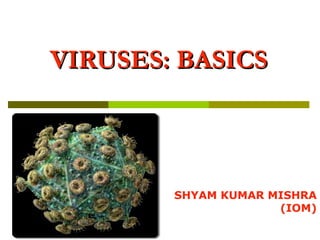
Virology introduction mbbs
- 1. VIRUSES: BASICSVIRUSES: BASICS SHYAM KUMAR MISHRA (IOM)
- 2. Classification scheme Microbial world Organisms Infectious agents (Living) (Nonliving) Bacteria Archae Eukarya (Prokaryotes) Algae Protozoa Fungi Helminthes Viruses Viroids PrionsVIRUSESVIRUSES
- 3. BeijerinckBeijerinck 19211921 Virus (Latin- poison and other noxious substances, first used in English in 1392) "Organisms at the edge of life” At the twilight zone separating the “living” from the “nonliving”. Living chemicals ???? Introduction
- 5. Introduction VirusesViruses - Obligate intracellular infectious agents (20-400 nm in diameter) containing only one kind of nucleic acid (DNA or RNA as their genome) 1000 nm = 1 µm Morphological definitions: Capsid- Protein shell or coat that encloses the nucleic acid genome Capsomers- Morphologic units composing the capsid; Shapes - vary (spherical/wedge)
- 7. Envelope- A lipid containing membrane that surrounds some virus particles and are acquired during viral maturation by a budding process through a cellular membrane of host cell Peplomers- Virus encoded glycoprotein exposed on the surface of the envelope (also known as spikes) Nucleocapsid- Capsid together with the enclosed N/A
- 8. VirionVirion – Complete virus particle Herpes, Orthomyxo viruses Nucleocapsid + Envelope Papova viruses, Picorna viruses Nucleocapsid Intactness of structure and the property of infectiousness
- 9. Origin of viruses Regressive hypothesis (degeneracy hypothesis) Viruses are remnants of cellular organisms. Progressive hypothesis or Cellular origin hypothesis (vagrancy hypothesis) Some viruses may have evolved from bits of DNA / RNA that "escaped" from the genes (plasmids or transposons) of a larger organism. Coevolution hypothesis (virus-first hypothesis) Viruses may have evolved from complex molecules of protein and nucleic acid at the same time as cells first appeared on earth.
- 11. Morphological Properties Size: 20-400 nm in diameter Shape: Mostly roughly spherical Rabies virus – bullet shaped Pox virus – brick shaped TMV – rod shaped
- 12. Structure/ Chemical composition: NUCLEIC ACID CORE VIRAL CAPSID ENVELOPE VIRAL PROTEINS
- 13. NUCLEIC ACID CORE (GENOME): StructureStructure: contains either DNA or RNA SizeSize: 3-3000 kbp StrandednessStrandedness: either single-stranded (RNA viruses except Reo-) or double-stranded (DNA viruses except Parvo-) SegmentationSegmentation: NA as single or several segments (Influenza virus has 8 RNA molecules, each carrying different genetic information. Such viruses are termed segmented viruses)
- 14. VIRAL CAPSID: COMPOSITION CapsomersCapsomers: morphological subunits FUNCTIONS Protection from physical, chemical and enzymatic damage Recognition of the host cell- (Viral attachment protein-VAP and cellular receptor)
- 16. ENVELOPE: Lipid bilayer (derived from host cell membrane) and virus-coded gp (peplomers) as spikes Matrix proteins: internal virion proteins that links the internal nucleocapsid Glycoproteins: Transmembrane proteins, anchored to the membrane; also includes transport channels (ion- channels) Influenza virus- Hemagglutinin and Neuraminidase
- 17. ENVELOPE FUNCTIONS Promote interaction with nucleocapsid proteins (final stage of assembly) Act as VAPs to cellular receptors Major viral antigens Interaction (spikes) with neutralizing antibodies Tegument: Herpesvirus nucleocapsid are enveloped but have a featureless layer of tegument interposed between the nucleocapsid and envelope. Function ????
- 18. VIRAL PROTEINS: Structural proteinsStructural proteins: essential for the formation of new viral particles. Some are associated with NA Some form protective layers (capsid and envelope) VAP Antigenicity EnzymesEnzymes: essential for initiation of replication Polymerases, Proteases, Endonucleases
- 20. Chemical Properties - Resistance Temperature: Enveloped viruses are more heat-labile Inactivated at 560 C-30’ (exception- HBV) and few sec at 1000 C. Some may be preserved by lyophilization Salts: 1 M salt solution e.g., MgCl2, MgSO4 pH: Usu. stable between pH 5 and 9 Enteroviruses – resistant to acidic conditions
- 21. Radiation: UV and ionising radiation inactivates viruses Photodynamic Inactivation Vital dyes- Toluidene blue; Visible light - Inactivation Disinfectants Most viruses are destroyed by oxidising agents such as chlorine, iodine and hydrogen peroxide. However, majority of viruses are resistant to phenol; chlorination does not always inactivate enteroviruses or hepatitis viruses, particularly if present with organic or faecal material.
- 22. Viral hemagglutination Hirst (1941) When viral particles are added to a red cell suspension, the virus particles are adsorbed to each red cell, bridge between them and bind them together forming a lattice Hemagglutinin + N-acetyl neuraminic acid (VIRUS + RBC) Agglutination occurs rapidly at 0o C Eluted at 37o C About 107 influenza virions are needed to cause hemagglutination visible to the naked eye.
- 24. Neuraminidase (Receptor destroying enzyme) Virus – No alteration Destroy receptor on RBCs Destruction of the surface receptors result in the reversal of haemagglutination and the release of the virus from the RBC cell surface. Epithelial cells of the respiratory tract have the same properties as those of RBCs so far as virus adsorption is concerned. Influenza virus normally remain confined to the respiratory tract because the protease enzyme that cleave HA are common only at those sites.
- 25. Hemagglutination inhibition Virus + Specific antiserum = Hemagglutination Influenza, Parainfluenza viruses – Fowl, Guinea pig, Human RBCs Adenovirus – Monkey, Mice Rabies virus – Pigeon
- 26. Classification-Basis Morphology Genome properties Physicochemical properties Protein properties Strategy of replication Antigenic properties Biologic properties Host specificity
- 27. Animal or plant virus (N=4000) 56 Families 233 genera
